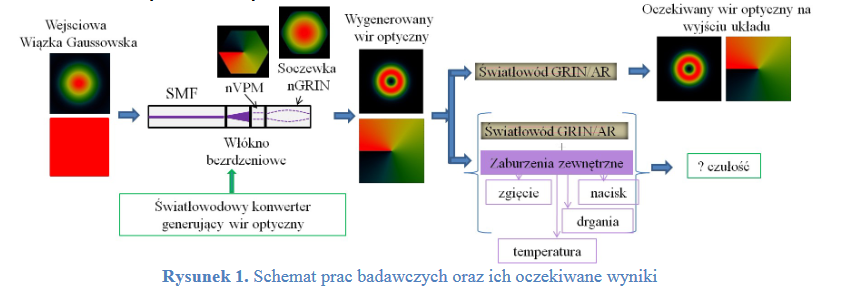Research project
Study on generation and transmission of optical vortex beam in all-fiber system with integrated nanostructured microoptical components
| dr Hue Thi Nguyen | Project leader |
An optical vortex beams is an extraordinary phenomenon which exhibits helical phase front and doughnut-like intensity distribution due to the phase singularity. The phase vortex having spiral phase front carries orbital angular momentum (OAM) associated with its topological charge. Those properties make this beam unique for optical trapping and rotating particles due to its phase rotation. Moreover, we can code the information in the form of OAM modes which allows increasing the transmission capacity of communication links. However, a difficulty here is how to create the vortex. Normally, complex systems are used for this purpose which include, for instance, resonators, phase plates either spatial light modulators. Recently, we have developed a method to make micro-elements for generate optical vortex beams using the nanostructurization technique. That means we can obtain the same vortices as previous methods by a very simple way with all flat-surface vortex phase masks (nVPM). Those components can be easily combined with the standard fibers to form a compact microprobe for converting Gaussian beams into vortex beams.
The objectives of this project will be verified using the existing vortices. Indeed, the fiber microprobe can be used for excitation of the vortex beam in anti-resonant (AR) fibers. This allows studying propagation of the vortex beam in the AR fiber and how it is influenced by external parameters. On one side, it is interesting if this propagation is stable and vortex is maintained in the fiber. However, vortices are known being very sensitive for even very small perturbations used in several experiments. The concept of guiding in anti-resonant fibers, to the best of our knowledge, has not been considered up to now. Therefore, the goal of this work is to develop a simple all-fiber system to generate optical vortex beams and check its stability and sensitivity for external perturbation during propagation in antiresonant fibers.

The schematic of works and expected results is represented in Fig. 1. In particular, we plan to focus on three main tasks: (i) optimization of fiber-based vortex converters with use of nVPM and nGRIN microlens to generate vortex beam with properties (beam diameter, numerical aperture) matching to anti-resonant fibers; (ii) characterization of the fiber-based vortex converter probe; (iii) Integration of the fiber-based vortex converter probe with antiresonant fiber and characterize its performance. Study of vortex propagation in the antiresonant fiber and its sensitivity on external perturbations.
As a result, this project can bring the new knowledge about the propagation of the vortex in anti- resonant fibers which can be used later on for sensor, fiber communication using hollow-core anti-resonant fibers with the generated air-hole vortex. Moreover, the obtained results will be disseminated in a form of PhD thesis and at least two papers published in the journals with IF.
- Nguyen H.T., Stepniewski G., Filipkowski A., Kasztelanic R., Pysz D., Van H.L., Stepien R., Klimczak M., Krolikowski W. and Buczynski R., 2022, Transmission of an optical vortex beam in antiresonant fibers generated in an all-fiber system, Optics Express, vol. 30(25), 45635-45647, 10.1364/OE.468461
